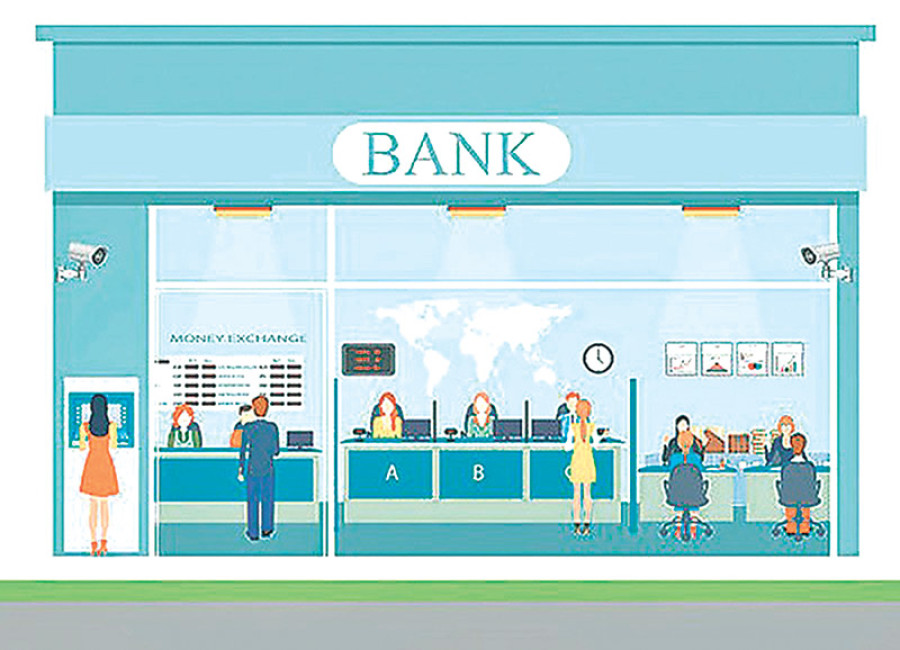Money
Is there urge to merge?
Did the central bank make a mistake by not pushing for merger of banks and financial institutions when recapitalisation process began in the banking sector two-and-a-half years ago?
Rupak D. Sharma
Did the central bank make a mistake by not pushing for merger of banks and financial institutions when recapitalisation process began in the banking sector two-and-a-half years ago? This question is now being asked as the ongoing problem of liquidity shortage faced by the banking sector is showing signs of becoming chronic.
In July 2015, the Nepal Rastra Bank, the central bank, told commercial banks to raise the minimum paid-up capital by four-fold to Rs8 billion within mid-July 2017.
At that time it also directed national-level development banks to raise minimum paid-up capital from Rs640 million to Rs2.5 billion, and told finance companies, including those operating in four to 10 districts, to raise the paid-up capital to Rs800 million from Rs300 million within the mid-July 2017 deadline.
Initially, the central bank had indicated merger would be the preferable option to raise the paid-up capital stock. But later Governor Chiranjibi Nepal publicly said investors should fork out funds themselves to recapitalise the institutions.
The governor’s comment lifted the sentiment of stock market investors, as it indirectly pushed banks and financial institutions to float a large number of bonus and rights shares. This is when the problem began.
To purchase rights shares up for grabs, most of the promoters of banks and financial institutions resorted to bank loans, absorbing a big chunk of credit, which should have gone to productive sectors and other areas.
Then as rights shares were purchased to raise the capital, promoters started exerting pressure on the management of banks and financial institutions to provide returns that matched the investment they had made. The only way for banking institutions to give a lift to profit is expansion of their core business activity, which is lending.
Banks followed this process. But quite a big chunk of the loans issued at that time were overdraft, which are risky in nature, as they are not generally used for the purpose mentioned at the time of borrowing the money.
There are now fears that these overdraft loans are also aiding the “credit ever-greening” process, a practice under which new loans are provided to borrowers to repay the old debt that is about to go sour.
This haphazard credit expansion spree of the last fiscal year, which was carried out without focusing too much on deposit collection, created an asset-liability mismatch, leading to shortage of funds that could be immediately disbursed as loans.
That scenario has repeated this year as well, leaving most of the commercial banks with very little stock of loanable fund.
“The banking sector probably would not have faced this problem had banks and financial institutions been told to raise the paid-up capital through mergers,” Himalayan Bank CEO Ashoke Rana said. “Had banking institutions been told to consolidate, the issue of floating rights shares would have become irrelevant.
This, in turn, would have reduced demand for loans in the last fiscal year and eased the pressure on banking institutions to generate higher profit. So the recapitalisation plan was ill-thought-out and not well debated.”
The central bank officials do not think they made the “mistake”.
They are still defending the move saying “one policy instrument should have one target, otherwise result may not be achieved”.
This is another way of saying that the central bank’s focus was solely on raising paid-up capital when the recapitalisation process began. “Had we focused on merger as well, we would neither have been able to consolidate the banking units nor succeeded in injecting fresh capital in banking institutions,” one central bank official said.
Talks about shake-up in the banking sector through mergers have long been making rounds given that close to 150 commercial banks, development banks, finance companies and microfinance development banks are serving an economy of around $26 billion.
Yet what cannot be ignored is the progress made by Nepal in reducing the number of banking institutions since the Merger Bylaw was introduced in April 2011. Since that time, 118 banks and financial institutions, including microfinance development banks, have been consolidated into 40 units.
Many are now calling for the launch of next wave of merger with focus on consolidation of commercial banks. This is because the policy on merger has not been able to reduce the number of big banks. At its peak, the number of commercial banks stood at 32. Today, there are still 28 commercial banks operating in Nepal.
“The argument for consolidation of commercial banks is becoming compelling now as many are engaging in cut-throat competition while fixing interest rate and attracting deposit,” said Nara Bahadur Thapa, executive director of the Research Department of the Nepal Rastra Bank. “There are also times when these institutions resort to unethical practices to gain an edge over competitors.”
These practices are expected to continue in the coming days as well, as remittance inflow is shrinking, putting pressure on deposit growth, and promoters are exerting pressure on banks to increase profit.
“Mergers will help shrink the number of banks in a sector that is fragmented. This will facilitate the regulator to ensure discipline in the industry and regulate businesses more closely,” Laxmi Bank CEO Sudesh Khaling said.




 9.12°C Kathmandu
9.12°C Kathmandu














